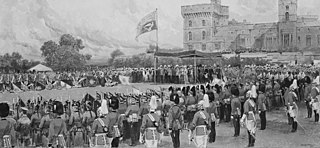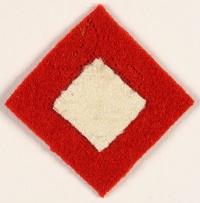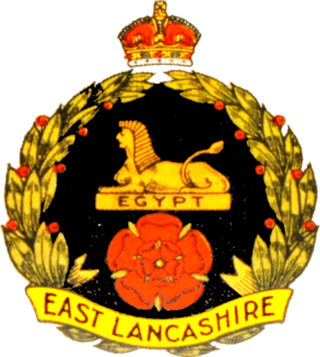
The 42nd Infantry Division was an infantry division of the British Army. The division was raised in 1908 as part of the Territorial Force (TF), originally as the East Lancashire Division, and was redesignated as the 42nd Division on 25 May 1915. It was the first TF division to be sent overseas during the First World War. The division fought at Gallipoli, in the Sinai desert and on the Western Front in France and Belgium. Disbanded after the war, it was reformed in the Territorial Army (TA), in the Second World War it served as the 42nd Infantry Division with the British Expeditionary Force (BEF) and fought in Belgium and France before being evacuated at Dunkirk. The division was later reformed in the United Kingdom and, in November 1941, was converted into the 42nd Armoured Division, which was disbanded in October 1943 without serving overseas. A 2nd Line duplicate formation, the 66th Infantry Division, was created when the Territorials were doubled in both world wars.

The Territorial Force was a part-time volunteer component of the British Army, created in 1908 to augment British land forces without resorting to conscription. The new organisation consolidated the 19th-century Volunteer Force and yeomanry into a unified auxiliary, commanded by the War Office and administered by local county territorial associations. The Territorial Force was designed to reinforce the regular army in expeditionary operations abroad, but because of political opposition it was assigned to home defence. Members were liable for service anywhere in the UK and could not be compelled to serve overseas. In the first two months of the First World War, territorials volunteered for foreign service in significant numbers, allowing territorial units to be deployed abroad. They saw their first action on the Western Front during the initial German offensive of 1914, and the force filled the gap between the near destruction of the regular army that year and the arrival of the New Army in 1915. Territorial units were deployed to Gallipoli in 1915 and, following the failure of that campaign, provided the bulk of the British contribution to allied forces in the Sinai and Palestine Campaign. By the war's end, the Territorial Force had fielded twenty-three infantry divisions and two mounted divisions on foreign soil. It was demobilised after the war and reconstituted in 1921 as the Territorial Army.

The Manchester Regiment was a line infantry regiment of the British Army in existence from 1881 until 1958. The regiment was created during the 1881 Childers Reforms by the amalgamation of the 63rd Regiment of Foot and the 96th Regiment of Foot as the 1st and 2nd battalions; the 6th Royal Lancashire Militia became the 3rd (Reserve) and 4th battalions and the Volunteer battalions became the 5th, 6th, 7th, 8th, 9th and 10th battalions.

The Lancashire Fusiliers was a line infantry regiment of the British Army that saw distinguished service through many years and wars, including the Second Boer War, and the First and Second World Wars. It had many different titles throughout its 280 years of existence.

The 66th Infantry Division was an infantry division of the British Army, which was active between September 1939 and June 1940 during the Second World War. In March 1939, after the re-emergence of Germany as a European power and its occupation of Czechoslovakia, the British Army increased the number of divisions within the Territorial Army by duplicating existing units. The 66th Infantry Division was formed in September 1939, as a second-line duplicate of the 42nd Infantry Division. The division's battalions were all raised in the Lancashire and Cumbria area.

The 42nd Armoured Division was an armoured division of the British Army raised during the Second World War.

The East Lancashire Regiment was, from 1881 to 1958, a line infantry regiment of the British Army. The regiment was formed in 1881 under the Childers Reforms by the amalgamation of the 30th (Cambridgeshire) Regiment of Foot and 59th Regiment of Foot with the militia and rifle volunteer units of eastern Lancashire. In 1958 the regiment was amalgamated with the South Lancashire Regiment to form the Lancashire Regiment which was, in 1970, merged with the Loyal Regiment to form the Queen's Lancashire Regiment. In 2006, the Queen's Lancashire was further amalgamated with the King's Own Royal Border Regiment and the King's Regiment to form the present Duke of Lancaster's Regiment.

The Border Regiment was a line infantry regiment of the British Army, which was formed in 1881 under the Childers Reforms by the amalgamation of the 34th (Cumberland) Regiment of Foot and the 55th (Westmorland) Regiment of Foot.

The Loyal Regiment (North Lancashire) (until 1921 known as the Loyal North Lancashire Regiment) was a line infantry regiment of the British Army that was in existence from 1881 to 1970. In 1970, the regiment was amalgamated with the Lancashire Regiment to form the Queen's Lancashire Regiment which was, in 2006, amalgamated with the King's Own Royal Border Regiment and the King's Regiment (Manchester and Liverpool) to form the Duke of Lancaster Regiment (King's, Lancashire and Border).

The Westmorland and Cumberland Yeomanry was a Yeomanry Cavalry regiment of the British Army with its origins in 1798. The regiment provided troops for the Imperial Yeomanry during the Second Boer War and served on the Western Front in the First World War, latterly as infantry. The regiment converted to artillery in 1920 and served as such in the early years of the Second World War, before becoming part of the Chindits in Burma. Postwar it served as a gunner regiment until 1971 when the title disappeared.

The 125th Brigade was an infantry brigade formation of the British Army that saw active service during both the First and Second World Wars. It was assigned to the 42nd Division and served in the Middle East and later in the trenches of the Western Front in the First World War. In the Second World War the brigade, now redesignated 125th Infantry Brigade, fought in Belgium and France before being evacuated at Dunkirk and was then converted into 10th Armoured Brigade.

The 126th Brigade was an infantry brigade of the British Army during the First World War and the Second World War. It was assigned to the 42nd Division and served in the Middle East and on the Western Front in the Great War. In the Second World War, now as the 126th Infantry Brigade, it served again with the 42nd Division in France and was evacuated at Dunkirk and then later converted into 11th Armoured Brigade.

The 127th (Manchester) Brigade was an infantry brigade of the British Army that saw active service during both the First and Second World Wars. It was assigned to the 42nd Division and served in the Middle East and on the Western Front in the First World War.
The 1st Lancashire Engineer Volunteer Corps was a Volunteer unit of Britain's Royal Engineers, first raised in 1860. It went on to spin off a unit of fortress engineers and provided a signals training centre during the First World War. Its successor units provided signal support for West Lancashire Territorial Army (TA) formations in the early stages of the Second World War, and for Eighth Army HQ during the Second Battle of El Alamein, the advance to Tunis, invasion of Sicily and through Italy, ending the war in Austria. Postwar successor units have continued in the TA and Army Reserve to the present day.
The 1st Manchester Rifles, later the 6th Battalion, Manchester Regiment, was a unit of Britain's Volunteer Force and Territorial Army recruited in and around Manchester. It served as infantry at Gallipoli, fighting with distinction at the Third Battle of Krithia, and in some of the bitterest battles on the Western Front in the First World War. After conversion into an anti-aircraft unit of the Royal Artillery between the wars, it defended Manchester, Scapa Flow and Ceylon during the Second World War and continued in the air defence role until 1955.

The East Lancashire Royal Engineers was a Volunteer unit of Britain's Royal Engineers raised in Manchester in 1901. It became the engineer component of the 42nd Division of the Territorial Force, seeing service in Egypt, at Gallipoli and on the Western Front during the First World War. In the Second World War, it took part in the Dunkirk evacuation with 42nd Division, and then converted to the armoured assault engineer role in 79th Armoured Division in North West Europe. Its duplicate unit served in Tunisia and Italy. The unit continues today as part of 75 Engineer Regiment in the Army Reserve.

42 Signal Regiment was a Territorial Army unit of the British Army's Royal Corps of Signals. It had its origins in a Volunteer unit of the Royal Engineers formed in Manchester during the Second Boer War. It provided the divisional signals during both world wars, and served with the 42nd Division, the 66th Division, and the 66th Infantry Division. Its successor continues in the Army Reserve as a Signal Troop in Manchester.

The 3rd Lancashire Artillery Volunteers was a unit of Britain's part-time Volunteer Force recruited from Blackburn and the surrounding area in 1860. It became a brigade of the Royal Field Artillery in the Territorial Force in 1908, and served through the First World War with the 42nd Division at Gallipoli, in Egypt and on the Western Front. Its second line unit also served on the Western Front in 1917–18. During the Second World War, its batteries operated in the light anti-aircraft role in Norway, France, Greece, Crete, North Africa and Italy. It was reformed postwar, but disappeared in a merger in 1955.

The Manchester Artillery is a Volunteer unit of the British Army first raised in the City of Manchester in 1860, whose successors continue to serve in the Army Reserve today. It became a brigade of the Royal Field Artillery in the Territorial Force in 1908, and in World War I it served in Egypt in 1915–17 before being broken up. Its second line unit went to the Western Front in 1917, seeing action at Ypres, against the German Spring Offensive, and leading the pursuit in the Allies' victorious Hundred Days Offensive. Just before World War II the Manchester Artillery again formed a duplicate. While the parent regiment served in the Battle of France including the Dunkirk evacuation, and later in the Middle East and the Italian campaign, its duplicate fought in Normandy and North West Europe. Both regiments were reformed postwar, but after a number of amalgamations they and several other Manchester-based units were reduced into 209 Battery in the present-day Army Reserve.

The Bolton Artillery, under various titles, has been a Volunteer unit of the British Army based in Bolton, Lancashire, since 1889. In the First World War it served in Egypt and Gallipoli in 1915–17, and then on the Western Front for the rest of the war, including Passchendaele, the German Spring Offensive and the Allied Hundred Days Offensive. Just before the outbreak of the Second World War the regiment formed a duplicate unit. The parent regiment served in the Battle of France and was evacuated from Dunkirk. Both regiments served at the Battle of Alamein and in the Italian campaign, while one of the regiments was involved in the intervention in Yugoslavia. The regiment was reformed postwar, and after a number of mergers its successors continue to serve in today's Army Reserve.













